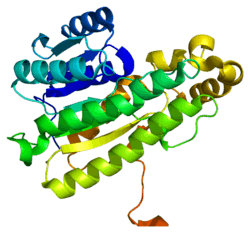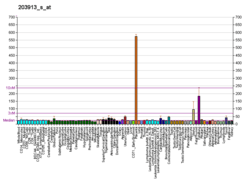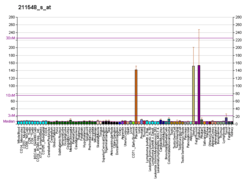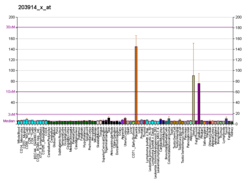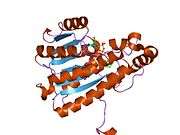HPGD
Hydroxyprostaglandin dehydrogenase 15-(NAD) (the HUGO-approved official symbol = HPGD; HGNC ID, HGNC:5154), also called 15-hydroxyprostaglandin dehydrogenase [NAD+], is an enzyme that in humans is encoded by the HPGD gene.[5][6]
In melanocytic cells HPGD gene expression may be regulated by MITF.[7]
See also
References
- 1 2 3 GRCh38: Ensembl release 89: ENSG00000164120 - Ensembl, May 2017
- 1 2 3 GRCm38: Ensembl release 89: ENSMUSG00000031613 - Ensembl, May 2017
- ↑ "Human PubMed Reference:".
- ↑ "Mouse PubMed Reference:".
- ↑ Persson B, Kallberg Y, Bray JE, Bruford E, Dellaporta SL, Favia AD, Duarte RG, Jornvall H, Kavanagh KL, Kedishvili N, Kisiela M, Maser E, Mindnich R, Orchard S, Penning TM, Thornton JM, Adamski J, Oppermann U (Feb 2009). "The SDR (short-chain dehydrogenase/reductase and related enzymes) nomenclature initiative". Chem Biol Interact. 178 (1-3): 94–8. PMC 2896744
 . PMID 19027726. doi:10.1016/j.cbi.2008.10.040.
. PMID 19027726. doi:10.1016/j.cbi.2008.10.040. - ↑ "Entrez Gene: HPGD hydroxyprostaglandin dehydrogenase 15-(NAD)".
- ↑ Hoek KS, Schlegel NC, Eichhoff OM, et al. (2008). "Novel MITF targets identified using a two-step DNA microarray strategy". Pigment Cell Melanoma Res. 21 (6): 665–76. PMID 19067971. doi:10.1111/j.1755-148X.2008.00505.x.
Further reading
- Erwich JJ, Keirse MJ (1992). "Placental localization of 15-hydroxy-prostaglandin dehydrogenase in early and term human pregnancy.". Placenta. 13 (3): 223–9. PMID 1635910. doi:10.1016/0143-4004(92)90037-T.
- Ensor CM, Yang JY, Okita RT, Tai HH (1990). "Cloning and sequence analysis of the cDNA for human placental NAD(+)-dependent 15-hydroxyprostaglandin dehydrogenase.". J. Biol. Chem. 265 (25): 14888–91. PMID 1697582.
- Ensor CM, Tai HH (1991). "Site-directed mutagenesis of the conserved tyrosine 151 of human placental NAD(+)-dependent 15-hydroxyprostaglandin dehydrogenase yields a catalytically inactive enzyme.". Biochem. Biophys. Res. Commun. 176 (2): 840–5. PMID 2025296. doi:10.1016/S0006-291X(05)80262-1.
- Krook M, Marekov L, Jörnvall H (1990). "Purification and structural characterization of placental NAD(+)-linked 15-hydroxyprostaglandin dehydrogenase. The primary structure reveals the enzyme to belong to the short-chain alcohol dehydrogenase family.". Biochemistry. 29 (3): 738–43. PMID 2337593. doi:10.1021/bi00455a021.
- Pichaud F, Frendo JL, Delage-Mourroux R, et al. (1995). "Sequence of a novel mRNA coding for a C-terminal-truncated form of human NAD(+)-dependent 15-hydroxyprostaglandin dehydrogenase.". Gene. 162 (2): 319–22. PMID 7557451. doi:10.1016/0378-1119(95)00319-2.
- Sangha RK, Walton JC, Ensor CM, et al. (1994). "Immunohistochemical localization, messenger ribonucleic acid abundance, and activity of 15-hydroxyprostaglandin dehydrogenase in placenta and fetal membranes during term and preterm labor.". J. Clin. Endocrinol. Metab. 78 (4): 982–9. PMID 8157731. doi:10.1210/jc.78.4.982.
- Krook M, Ghosh D, Duax W, Jörnvall H (1993). "Three-dimensional model of NAD(+)-dependent 15-hydroxyprostaglandin dehydrogenase and relationships to the NADP(+)-dependent enzyme (carbonyl reductase).". FEBS Lett. 322 (2): 139–42. PMID 8482380. doi:10.1016/0014-5793(93)81554-D.
- Pichaud F, Delage-Mourroux R, Pidoux E, et al. (1997). "Chromosomal localization of the type-I 15-PGDH gene to 4q34-q35.". Hum. Genet. 99 (2): 279–81. PMID 9048936. doi:10.1007/s004390050354.
- Delage-Mourroux R, Pichaud F, Frendo JL, et al. (1997). "Cloning and sequencing of a new 15-hydroxyprostaglandin dehydrogenase related mRNA.". Gene. 188 (1): 143–8. PMID 9099873. doi:10.1016/S0378-1119(96)00800-1.
- Patel FA, Clifton VL, Chwalisz K, Challis JR (1999). "Steroid regulation of prostaglandin dehydrogenase activity and expression in human term placenta and chorio-decidua in relation to labor.". J. Clin. Endocrinol. Metab. 84 (1): 291–9. PMID 9920098. doi:10.1210/jc.84.1.291.
- Zhou H, Tai HH (1999). "Threonine 188 is critical for interaction with NAD+ in human NAD+-dependent 15-hydroxyprostaglandin dehydrogenase.". Biochem. Biophys. Res. Commun. 257 (2): 414–7. PMID 10198228. doi:10.1006/bbrc.1999.0356.
- Greenland KJ, Jantke I, Jenatschke S, et al. (2000). "The human NAD+-dependent 15-hydroxyprostaglandin dehydrogenase gene promoter is controlled by Ets and activating protein-1 transcription factors and progesterone.". Endocrinology. 141 (2): 581–97. PMID 10650939. doi:10.1210/en.141.2.581.
- Conner CE, Kelly RW, Hume R (2001). "Regulation of prostaglandin availability in human fetal lung by differential localisation of prostaglandin H synthase-1 and prostaglandin dehydrogenase.". Histochem. Cell Biol. 116 (4): 313–9. PMID 11702189. doi:10.1007/s004180100323.
- Giannoulias D, Patel FA, Holloway AC, et al. (2002). "Differential changes in 15-hydroxyprostaglandin dehydrogenase and prostaglandin H synthase (types I and II) in human pregnant myometrium.". J. Clin. Endocrinol. Metab. 87 (3): 1345–52. PMID 11889207. doi:10.1210/jc.87.3.1345.
- Cho H, Tai HH (2003). "Threonine 11 of human NAD(+)-dependent 15-hydroxyprostaglandin dehydrogenase may interact with NAD(+) during catalysis.". Prostaglandins Leukot. Essent. Fatty Acids. 66 (5-6): 505–9. PMID 12144871. doi:10.1054/plef.2002.0391.
- Strausberg RL, Feingold EA, Grouse LH, et al. (2003). "Generation and initial analysis of more than 15,000 full-length human and mouse cDNA sequences.". Proc. Natl. Acad. Sci. U.S.A. 99 (26): 16899–903. PMC 139241
 . PMID 12477932. doi:10.1073/pnas.242603899.
. PMID 12477932. doi:10.1073/pnas.242603899. - Tai HH, Ensor CM, Zhou H, Yan F (2003). "Structure and function of human NAD(+)-linked 15-hydroxyprostaglandin dehydrogenase.". Adv. Exp. Med. Biol. 507: 245–50. PMID 12664592. doi:10.1007/978-1-4615-0193-0_37.
- McKeown KJ, Challis JR (2003). "Regulation of 15-hydroxy prostaglandin dehydrogenase by corticotrophin-releasing hormone through a calcium-dependent pathway in human chorion trophoblast cells.". J. Clin. Endocrinol. Metab. 88 (4): 1737–41. PMID 12679466. doi:10.1210/jc.2002-021369.
- Patel FA, Funder JW, Challis JR (2003). "Mechanism of cortisol/progesterone antagonism in the regulation of 15-hydroxyprostaglandin dehydrogenase activity and messenger ribonucleic acid levels in human chorion and placental trophoblast cells at term.". J. Clin. Endocrinol. Metab. 88 (6): 2922–33. PMID 12788907. doi:10.1210/jc.2002-021710.
- Nandy A, Jenatschke S, Hartung B, et al. (2004). "Genomic structure and transcriptional regulation of the human NAD+-dependent 15-hydroxyprostaglandin dehydrogenase gene.". J. Mol. Endocrinol. 31 (1): 105–21. PMID 12914529. doi:10.1677/jme.0.0310105.
This article is issued from
Wikipedia.
The text is licensed under Creative Commons - Attribution - Sharealike.
Additional terms may apply for the media files.
